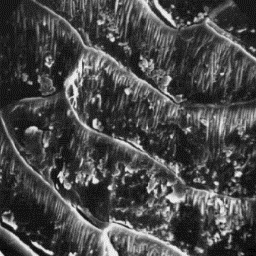 Ovis aries - Valaska lamb skin
Ovis aries - Valaska lamb skin
------------------------------
English: Sheep
German: Hausschaf
French: Mouton
Spanish: Ovejas
The sheep is one of the oldest domes-
ticated animals and, today, many varieties
are bred in all the inhabited continents.
The species can be classified into three
groups according to the wool quality: the
fine wool type, the semi-fine wool type and
the coarse wool type. Zoologically, the
sheep could be classified into four groups.
In the first group are the fatty-tailed The cuticular structure
sheep, yielding high quality Persian furs, of a guard hair, 2000x
for example Kara-kul, Balcanian, Moldavian,
Bagdad type and others. In the second group are the wide- backed sheep, with
semi-Persian wool, for example, the Astrakhan, Tibetian, Indian, Pakistan and
Afghanistan breeds. The third group covers the short-tailed breeds with coarse
wool. These sheep are the older and, today industrially less important types
and, for fur purposes, only lamb skins are used. The last group are the
thin-tailed sheep, with a fine wool coat, which are the most important in the
wool industry. The main representatives of this group are the merino species
and similar fine wool-coated types.
|
|
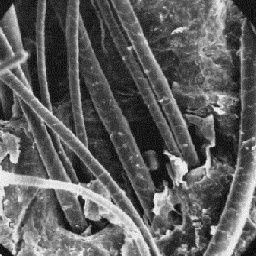 Ovis aries - Valaska lamb skin
Ovis aries - Valaska lamb skin
------------------------------
English: Sheep
German: Hausschaf
French: Mouton
Spanish: Ovejas
Distribution areas
------------------
The valaska sheep is of the coarse-wool
variety. In the past, these sheep were most
widely bred in Central and Eastern Europe.
Now this type is only scarcely raised. Some
crossbred mutations with an improved wool
quality are more common.
The surface structure
Description of the fur of the skin, 200x
----------------------
The valaska lamb skins are usually white in colour; only some have a black
or black-white spotted coat. The weight of the dry skin is usually up to 1 kg
and the area is in the range of 80 to 400 cmý. The wool fibres are only
moderately curled, and the coarse fibres are easily broken. The thickness of
the coat is between 20 and 35 mm.
|
|
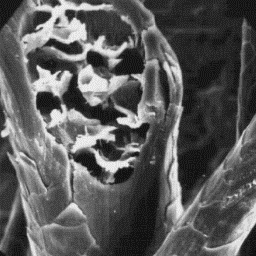 Ovis aries - Valaska lamb skin
Ovis aries - Valaska lamb skin
------------------------------
English: Sheep
German: Hausschaf
French: Mouton
Spanish: Ovejas
Structure of the hair
---------------------
The microscopic structure of the skin
surface is furrowed, and the hair follicles
are narrow with straight edges. The average
follicles contain only one hair shaft.
The fine fur fibres are circular in
cross-sectional outline with a diameter of Transverse section
about 15 to 30 µm. The cuticular scales are of an intermediate fibre, 600x
cornet-like or even tile-like shaped. The
scale surface is smooth and the margins are straight. The fine fur fibres are
non-medullated.
|
|
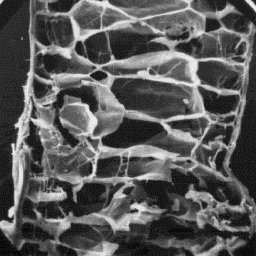 Ovis aries - Valaska lamb skin
Ovis aries - Valaska lamb skin
------------------------------
English: Sheep
German: Hausschaf
French: Mouton
Spanish: Ovejas
The intermediate fibres have a circular
and, in the upper part of the shaft
ellipsoidal, cross-section with a diameter
of about 35 to 80 µm. The cuticle is
composed of even tile-like scales with a
non-regular grooved surface and straight
scale margins. The medullar column is wide,
unbroken and central symmetrical-shaped in
cross-section. The overall structure Longitudinal section
belongs to the lattice type with a of a guard hair, 400x
complex-sheet-like infilling material.
The guard hairs usually have a sickle-shaped or dumb-bell-shaped
cross-sectional outline with a diameter at the widest part of about 80 to 160
µm. The cuticular scales are even tile-like with a non-regular grooved
surface and straight margins. The medullar column is of the predominating
type, especially in the wider upper parts of the shaft. The medulla is
unbroken, central symmetrical-shaped and belongs to the lattice type with a
needle-sheet-like infilling substance.
|
|
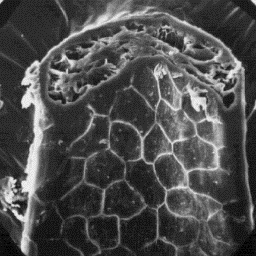 Ovis aries - Valaska lamb skin
Ovis aries - Valaska lamb skin
------------------------------
English: Sheep
German: Hausschaf
French: Mouton
Spanish: Ovejas
Transverse section
of a guard hair, 400x
Numerical code for valaska lamb skin structure
----------------------------------------------
Surface of the skin: 3-4-1
Fine fur fibres: 1-2.5-1-1-4-0-0-0-0-15.31-8.25
Intermediate fibres: 2.1-2-3-1-2-1-1-8-4-35.81-15.41
Guard hairs: 4.8-1-3-1-1-1-1-8-3-80.161-25.55
|




